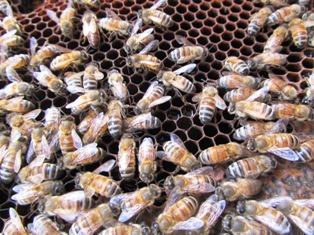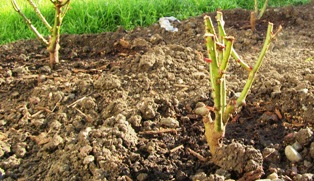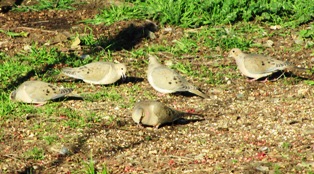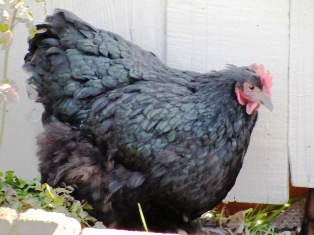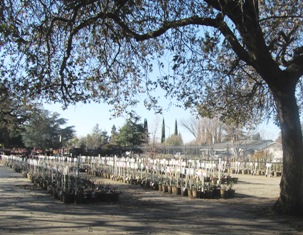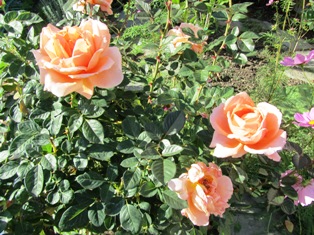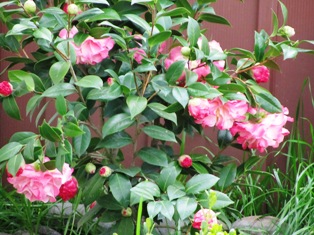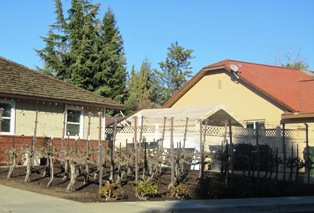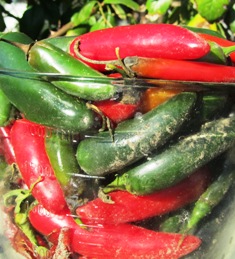Archive for January, 2013
Food for Bee Babies
The bee suit I’ve worn this morning smells like smoke from the smoker. My neighbor opened his hives today to check on the status of the bees and I was happy to help. I learn something new every time I work with him. We’ve had freezing nights with the temps hovering below 30 degrees Fahrenheit, not good for bees.
Upon opening the first hive, we could see the bees were docile. After all, it is winter. The bees must work hard to keep heat in the hive and they aren’t expecting us to be intruding into their world. In fact, my neighbor didn’t bother with putting on either the beekeeper suit or the elbow-length leather gloves. He loves his bees and has no fear of being stung.
Our work today was putting into each super a patty of brood building food (mainly high fructose corn syrup, soy flour, and other nutrients) as a substitute for pollen, especially necessary to feeding bees. Beekeepers often feed their bees in late winter or early spring since there is little pollen to be scavenged from flowers. Flower and blossom pollen comes later in the spring.
We must do all we can to help the beleaguered little honeybees. We have even covered their hives with blankets, reducing the necessary labor of the worker bees in keeping the hive humming and warm.
So I don’t mind smelling a little like smoke for a while to help the bees, and I’m hoping the bees won’t mind that I took one little frame of honey from their hive to my kitchen.
A Scrub Jay to Keep Me Company
A Western scrub jay darts into the yard, drops to the ground, and investigates the pottery saucer then pecks at small red berries that have fallen from the giant pepper tree along the back fence. The jay visits almost daily, but the rest of the wildlife seems to have taken cover, maybe because it’s so cold out.
The citrus trees have been covered for a few days with blankets and thick sheeting of black plastic since freezing temperatures are forecast for several days. It’s darn chilly and if the rain comes that is also forecast, we could see a dusting of snow around the top of Mount Diablo.
In early December, I walked around the farmette in shirt sleeves, but today it’s taken three layers of sweaters, two pairs of socks, and long johns under jeans to stay warm. You’d think I was dressing for a visit to Siberia.
This will be a short break. Indoors, I’m working on my own book and editing another one for a friend. My exercise period won’t be long, but at least a walk around the farmette gets blood flowing to my brain, exposes me to the sun for an all important daily dose of vitamin D, and allows me to breathe fresh air. So even if it is only the jay keeping me company, the pleasure is all mine.
Outdoor Projects on the Farmette
During winter when rain is frequent and freezing nights seem more common than they used to be in Northern California, we permit the land to rest. This season is perfect for reviewing our master plan for the property and the outdoor projects ahead of us.
We still have work to do on our house but we are thinking of outdoor entertaining spaces, too.
We get great ideas while visiting local nurseries and do-it-yourself supply centers, but we resist the temptation to start any new outdoor project until the weather has warmed. Also we don’t plant shrubs, roses, or trees in the garden without considering how doing so might impact our overall garden design.
The exception is heeling in a bare-root plant. That means we put a plant into a temporary hole in the ground to keep the roots from drying out before moving it to its permanent location. We don’t want our plants to break dormancy too soon because a frosty night could damage new plant growth.
While we stroll around the property, we discuss landscape plans for this new year. Frequently, we stop to watch the birds feeding and squirrels foraging. We talk about which area of the farmette might be the best location for a house expansion, utility shed, or outdoor kitchen.
Carlos has a strong aesthetic sense about design. He’s created some lovely outdoor kitchens. Since he takes into consideration the environment as well as functionality in his designs, he’s already thinking about building sites on our property that capitalize on the various views we have of Mt. Diablo but that are not too far away from the house.
Just listening to Carlos talk about his design ideas inspires me to think about grilling in the to-be-built outdoor kitchen, perhaps fresh figs and melted goat cheese or oysters (with garlic butter, shallots, and fresh Parmesan). We love sharing food with friends and neighbors in an outdoor spaces during nice weather, but for now our small patio will have to suffice.
We keep chipping away at what needs to be done, finishing one thing , crossing it off the list, and moving on to the next. The outdoor kitchen is pretty far down on a long list of things to do. But as the old adage goes: Hope springs eternal.
Missing My Chickens
My next door neighbor welcomed us to the neighborhood when we bought the Henny Penny Farmette. He gave us produce from his garden, honey from his hives, eggs, and even the chickens that laid them. We didn’t even have a chicken house back then.
That didn’t stop us. It was summer, I was married to an architect/builder, and we put “build a chicken house” on our list of things to do.
It took about a week to build out the chicken house. The best time to transport chickens are at night when they are calm. You go into their old roost after dark and carry them to their new dwelling.That way, they awaken at dawn in their new home, and the move is a fait accompli.
After the six laying hens moved in, I named them. The white one seemed especially flighty so she became flighty Tighty Whitey. There were two brown hens, Click and Clack; two Mediterranean hens, Henrietta and Heloise; and Mystery, the large black Cochin, who wouldn’t lay many eggs but loves to sit on them.
Since my neighbor believes that every hen house needs a rooster, he brought over a cute little whipper snapper that I named Houdini. What Houdini lacked in height and weight (he was after all a Bantam), he made up for in attitude.
Carlos outdid himself building that chicken house. He insulated it, tiled the floor, put in nesting boxes all along one wall (with little windows that could be opened so you could reach in to gather eggs), and a red thermal light for heat.
One day, inspectors from the city came out to look for standing water before mosquito season began and spotted the spiffy new chicken house. One fellow joked, “If those chickens don’t like it, call me. I’m looking for a new place.”
I grew attached to the chickens; so much so that when I lost two because of prolapsed cloaca, I mourned them as if family members had passed. Then last year, each time I cleaned the chicken house I suffered an asthma attack. This occurred in spite of wearing a mask the entire time I cleaned it. The chickens needed a clean house, but I could no longer be the cleaning lady.
I could not find takers for that job, so with a heavy heart I decided to give my chickens to a Lebanese lady. She wanted the chickens and had family members who would help her take good care of the brood. All the chickens except Mystery moved to the lady’s chicken house. Mystery moved back into the coop next door.
I miss the contented clucking of the chickens as they scratched their way around my yard. I miss Houdini’s gravely cockle-doodle-doo that awakened me before dawn. And I miss the fresh eggs that I would happily gather each morning from the splendid chicken house that Carlos built.
I’m fortunate that my neighbor kindly supplies me with organic eggs from his chickens. When I really get to missing the chickens, I popped over the fence to visit Mystery. Maybe she misses me, too. When I call her name she still answers.
Lately, I’ve been thinking about building a new chicken house with room for one or two chickens. I’d like to be able to move it around the yard on wheels. It would have to be tall enough to contain a roost and it would have to accommodate a nesting box or two, and include a wired section like a big box that could be detached. The whole thing wouldn’t need much cleaning. So, now I I’m trying to find the right time to broach the subject with my architect in residence.
Self Care to Release Tension from Farmette Work and Worry
Even before I get out of bed each morning, I meditate. Once my feet hit the floor in our little farm house, I’m working–making coffee, preparing breakfast, and starting laundry. The cell phones begin ringing by eight. It seems virtually impossible to find quiet time after that hour.
The great risk of meditating while lying down is falling back asleep. Sleeping is not meditating.
The mind’s natural tendency is to endlessly flit from thought to thought, like a chicken ever moving and scratching the soil surface for the treasures it holds (worms, bugs, grains). The person meditating aims for focused concentration of the mind to gain the treasure of peace.
A simple practice is to count each cycle of breaths, attaching a number at the end of a cycle: In-out-one, In-out-two. Alternatively, you could repeatedly recite a mantra or prayer. A rosary or prayer beads can help you to keep a count. Meditation is not a religion (although it is associated with some). It is self-care.
Benefits to practicing meditation for even 15 to 20 minutes daily are extraordinary. Through deep mind-body relaxation, you reduce stress and tension accumulated and held in the body. Meditation has been shown to lower heart and respiratory rates, decrease blood pressure, and improve blood flow and circulation. Concentration and brain power improves.
A few years ago, I teamed up with Carolyn Dean, M.D. to write 356 Ways to Look and Feel Younger (Adams Media 2009), a book that explores more of the benefits of meditation and provides daily tips on building muscle, boosting memory, and achieving vibrant health.
My meditation teacher was a powerful yet unassuming Indian who lived in a small village in Gujarat, India where I stayed in the early 1970s. The simple technique of counting breaths I learned from him has always helped me in the stressful types of work I’ve undertaken.
As a respiratory therapist for a large county hospital, I worked in an emergency room and five intensive care units as well as participated in ambulance and helicopter transports of patients. Later, I directed Hollywood screenwriting conferences. Now I work long hours on the farmette, no less stressful but a different kind of work than treating patients or working with writers, producers, and directors.
Through meditation, I rid my body of tension and stress, cultivate a mindful attitude toward all areas of my life, and function more efficiently. Digging fence post holes, caulking windows, chasing chickens, planting trees, canning jams, and harvesting honey requires abundant energy and clear focus. Daily meditation and self care make all the work associated with living such a full life possible without issues associated with physical or mental decline.
Visiting a Favorite Nursery to Check on New Offerings
Seed catalogs are fun to read, but what better way to start off the new year than with a visit to a local nursery. Our favorite is Alden Lane Nursery, in Livermore, California, about 15 miles from the Henny Penny Farmette. See, http://www.aldenlane.com.
There are many reasons why I like this nursery. For starters, it offers over 200 varieties of roses, one of the largest rose collection I’ve ever seen in any of our local nurseries. The nursery maintains a large number of David Austin and Romantica roses.
I grew three dozen different roses in San Jose and here on the farmette, I’ve already planted about two dozen floribundas, grandifloras, hybrid teas, and climbers. I especially love my Abbaye de Cluny and A Shropshire Lad roses. These two are beautiful roses, nearly carefree, and reward us with gorgeous blooms.

A window frame, painted and screwed to a rectangular box, can be mounted on a shed wall for interest in the garden
During my visit to Alden Nursery, I spotted lots of pots and yard art as well as a variety of different fruit trees espaliered on trellises. It got me thinking that perhaps and apple grafted with several varieties and trained as an espalier might look attractive against the wall of my chicken house.
An espaliered fruit tree is one in which the branches of the tree are trained against a wall or other support and are prune in such a way as to allow the fruit to grow along its cordons. Read more about espaliered fruit trees at http://www.pallensmith.com/articles/espaliered-fruit-trees.
Alden Nursery staff suggest the following garden chores be done in January and February: plant seed potatoes, prune fruit trees, apply iron sulfate to promote green color in acid loving plants, feed the lawn, plant new camellias, and add three to four inches of mulch around the bases of trees and shrubs, and ensure that frost tender plants are protected against plummeting temperatures.
Other chores include applying aluminum to soil to change a pink hydrangea to blue (or use the Hydra Blue product), spraying roses with Bonide All Seasons Spray Oil (it’s plant-based for organic gardens), and pruning evergreen shrubs.
Before leaving the nursery, I snapped a picture of an Adirondack chair. My architect-in-residence (also known as my spouse) is a whiz at looking at something and then making it. I explained to him how happy it would make me if we could create a pair of similar chairs for my garden from recycled materials.
On the way home, we passed some open fields with land for sale. Perched on a post was a Cooper’s hawk (although I’m not entirely sure about this identification). The hawk did not shift its position, and I could not see any shoulder or tail bands or back markings. It had a fairly tubular body and thin legs but no red eyes. If you know what kind of hawk it is, please let me know.
Livermore Valley is making a name for itself as a significant wine region south of Napa. The valley is home to many vineyards and wine aficionados. As we drove away from the nursery, we spotted a little vineyard tucked into a resident’s front yard. It was altogether a lovely day for a visit to the nursery. We’ll return in two weeks when the staff has put out all the new bare-root fruit trees, berries, and grapes. Until then, I’ll be reading the seed catalogs stacked on my desk.
Transitioning between the Seasons
Now that we’ve entered a new year and a new season, I’ve reluctantly pulled the last of the chili pepper plants from my garden. This past summer I grew Anaheim, ancho, chiles de arbol (hot and related to cayenne), banana (also known as yellow wax peppers), and jalapeno (called chipotle whenever the chilies are smoked). I save the seeds in white paper envelopes for replanting and use the chilies in cooking my Hispanic, Caribbean, Indian, Southwestern, and Thai dishes.
Cooks the world over love chilies for the flavors they add to their cuisines, however, chilies contain oils that can irritate skin and eyes. When harvesting seeds from chili peppers, I wear latex gloves (like surgeons wear). The gloves protect my fingers and hands from the oils but allow me to easily work with the chilies.
A little tip about gauging the heat of chilies is to look at the top (shoulder) and tip (pointed end). If the top is wide and the tip is blunt, the chili will be milder than a chili with a narrow top and a pointed end. See, http://whatscookingamerica.net/chilepep.htm.
I opted not to put in winter season crops this year. The clay soil needs turning (with a rototiller) and more amendments. With the vegetable garden devoid of plants now except for vagrant lettuces, carrots, and potatoes, I do winter clean-up chores such as composting, pruning, and preparing beds for spring.
The Bay Area forecast for the inland valleys last night predicted plunging temperatures and a hard freeze. I covered the citrus trees with blankets and a heavy sheet of black plastic. At sunup, the temperatures still hovered around 30 degrees Fahrenheit, and white hoar frost covered everything in the garden, including the sheeting.
A garden needs winter–a time of rest, dormancy, and chill. Some plants require many hours of chilling to perform well. Freezes also eliminate some garden pests.
Our neighbor graciously gave us some bulbs a year ago that we planted in the fall. Now they’ve sprouted and are blooming. These white jonquil blooms are similar to those grown in my mother and grandmother’s gardens (although their jonquils were yellow with orange-yellow centers). The blooms add welcome color to the otherwise monochromatic winter landscape. These and other bulbs we’ve planted will eventually render some color in the garden and hopefully a little pollen for the honeybees while we wait for winter to transition into spring.
 Facebook
Facebook Goodreads
Goodreads LinkedIn
LinkedIn Meera Lester
Meera Lester Twitter
Twitter



